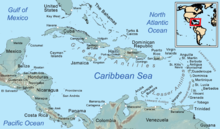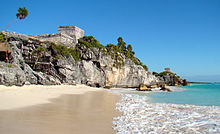
Caribbean Sea
Background to the schools Wikipedia
SOS Children volunteers helped choose articles and made other curriculum material SOS Child sponsorship is cool!
| Caribbean Sea | |
|---|---|
|
|
The Caribbean Sea is a sea of the Atlantic Ocean located in the tropics of the Western hemisphere. It is bounded by Mexico and Central America to the west and southwest, to the north by the Greater Antilles, to the east by the Lesser Antilles, and to the south by South America.
The entire area of the Caribbean Sea, the numerous islands of the West Indies, and adjacent coasts, are collectively known as the Caribbean. The Caribbean Sea is one of the largest seas and has an area of about 2,754,000 km² (1,063,000 sq. mi.). The sea's deepest point is the Cayman Trough, between the Cayman Islands and Jamaica, at 7,686 m (25,220 ft) below sea level. The Caribbean coastline has many gulfs and bays: the Gulf of Gonâve, Gulf of Venezuela, Gulf of Darién, Golfo de los Mosquitos, Gulf of Paria and Gulf of Honduras.
History
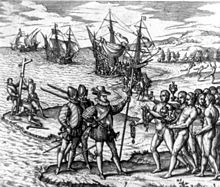
The name "Caribbean" is derived from the Caribs, one of the dominant American Indian groups in the region at the time of European contact during the late 15th century. After the discovery of the West Indies by Christopher Columbus in 1492, the Spanish term Antillas was assigned to the lands; stemming from this, "Sea of the Antilles" is a common alternative name for the Caribbean Sea in various European languages. During the first century of development, the Spanish dominance was undisputed.
The Caribbean Sea was an unknown body of water to the populations of Eurasia until 1492, when Christopher Columbus first sailed into Caribbean waters on a quest to find a sea route to Asia. At that time the Western Hemisphere in general was unknown to Europeans. Following the discovery of the islands by Columbus, the area was quickly colonised by several Western cultures (initially Spain, then later Portugal, England, the Dutch Republic, France and Denmark). Following the colonisation of the Caribbean islands, the Caribbean Sea became a busy area for European-based marine trading and transport, and this commerce eventually attracted piracy.
Today the area is home to 22 island territories and borders 12 continental countries. Due to the abundance of sunshine, year-round tropical temperatures moderated by the almost constant trade winds, and the great variety of scenic destinations to visit, during the second half of the 20th century on into the 21st, the Caribbean Sea became a popular place for tourism.
Extent
The International Hydrographic Organization defines the limits of the Caribbean Sea as follows:
-
- In the Yucatan Channel. The same limit as that described for the Gulf of Mexico [A line joining Cape Catoche Light ( 21°37′N 87°04′W) with the Light on Cape San Antonio in Cuba].
-
- On the North. In the Windward Channel - a line joining Caleta Point (74°15'W) and Pearl Point (19°40'N) in Haïti. In the Mona Passage - a line joining Cape Engano and the extreme of Agujereada ( 18°31′N 67°08′W) in Puerto Rico.
-
- Eastern limits. From Point San Diego (Puerto Rico) Northward along the meridian thereof (65°39'W) to the 100 fathom line, thence Eastward and Southward, in such a manner that all islands, shoals and narrow waters of the Lesser Antilles are included in the Caribbean Sea as far as Galera Point (Northeast extremity of the island of Trinidad). From Galera Point through Trinidad to Galeota Point (Southeast extreme) and thence to Baja Point ( 9°32′N 61°0′W) in Venezuela.
Geology
The Caribbean Sea is an oceanic sea largely situated on the Caribbean Plate. Estimates of the sea's age range from 20,000 years to 570 million years. The Caribbean sea floor is divided into five basins separated from each other by underwater ridges and mountain ranges. Atlantic Ocean water enters the Caribbean through the Anegada Passage lying between the Lesser Antilles and Virgin Islands and the Windward Passage located between Cuba and Haiti. The Yucatan Channel between Mexico and Cuba links the Gulf of Mexico with the Caribbean. The deepest points of the sea lie in Cayman Trough with depths reaching approximately 7,686 m (25,220 ft). Despite this, the Caribbean Sea is considered a relatively shallow sea in comparison to other bodies of water.
The Caribbean sea floor is also home to two oceanic trenches: the Hispaniola Trench and Puerto Rico Trench, which put the area at a higher risk of earthquakes. Underwater earthquakes pose a threat of generating tsunamis which could have a devastating effect on the Caribbean islands. Scientific data reveals that over the last 500 years the area has seen a dozen earthquakes above 7.5 magnitude. Most recently, a 7.1 earthquake struck Haiti on January 12, 2010.
- List of islands in the Caribbean
Ecology
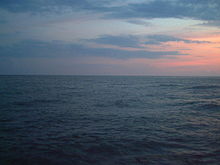
The Caribbean is home to about 9% of the world's coral reefs covering about 20,000 square miles (52,000 km2), most of which are located off the Caribbean Islands and the Central American coast.
During the past ten years, unusually warm Caribbean waters have been increasingly threatening Caribbean coral reefs. Coral reefs support some of the most diverse marine habitats in the world, but they are fragile ecosystems. When tropical waters become unusually warm for extended periods of time, microscopic plants called zooxanthellae, which are symbiotic partners living within the coral polyp tissues, die off. These plants provide food for the corals, and give them their colour. The result of the death and dispersal of these tiny plants is called coral bleaching, and can lead to the devastation of large areas of reef.
The habitats supported by the reefs are critical to such tourist activities as fishing and diving, and provide an annual economic value to Caribbean nations of $3.1-$4.6 billion. Continued destruction of the reefs could severely damage the region's economy. A Protocol of the Convention for the Protection and Development of the Marine Environment of the Wider Caribbean Region came in effect in 1986 to protect the various endangered marine life of the Caribbean through forbidding human activities that would advance the continued destruction of such marine life in various areas. Currently this protocol has been ratified by 15 countries. Also several charitable organisations have been formed to preserve the Caribbean marine life, such as Caribbean Conservation Corporation which seeks to study and protect sea turtles while educating others about them.
Weather
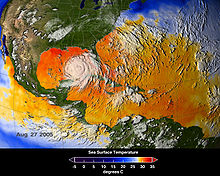
The Caribbean weather is influenced by the Gulf Stream and Humboldt Current ocean currents. The tropical location of the sea helps the water to maintain a warm temperature ranging from the low of 70 to mid-80 Fahrenheit (21-29 C°) by the season.
The Caribbean is a focal area for many hurricanes within the Western Hemisphere. A series of low pressure systems develop off the West coast of Africa and make their way across the Atlantic Ocean. While most of these systems do not become tropical storms, some do. The tropical storms can develop into Atlantic hurricanes, often in the low pressure areas of the eastern Caribbean. The Caribbean hurricane season as a whole lasts from June through November, with the majority of hurricanes occurring during August and September. On average around 9 tropical storms form each year, with 5 reaching hurricane strength. According to the National Hurricane Centre 385 hurricanes occurred in the Caribbean between 1494 and 1900.
Every year hurricanes represent a potential threat to the islands of the Caribbean, due to the extremely destructive nature of these powerful weather systems. Coral reefs can easily be damaged by violent wave action, and can be destroyed when a hurricane dumps sand or mud onto a reef. When this happens, the coral organisms are smothered and the reef dies and ultimately breaks apart.
Economy and human activity

The Caribbean region has seen a significant increase in human activity since the colonisation period. The sea is one of the largest oil production areas in the world, producing approximately 170 million tons per year. The area also generates a large fishing industry for the surrounding countries, accounting for half a million metric tons of fish a year.
Human activity in the area also accounts for a significant amount of pollution, The Pan American Health Organization estimated in 1993 that only about 10% of the sewage from the Central American and Caribbean Island countries is properly treated before being released into the Sea.
The Caribbean region supports a large tourist industry. The Caribbean Tourism Organization calculates that about 12 million people a year visit the area, including (in 1991–1992) about 8 million Cruise Ship tourists. Tourism based upon scuba diving and snorkeling on coral reefs of many Caribbean islands makes a major contribution to their economies.
Popular culture
The Caribbean is the setting for countless literary efforts often related to piracy acts and swashbuckling. One memorable work of pulp fiction has in its title a geographic feature unique in its way to the islands: Fear Cay, the eleventh Doc Savage adventure by Lester Dent. Many James Bond adventures were set there. All of the action of the Monkey Island series videogames takes place within the Caribbean sea area. It is also well known as the location of the Pirates of the Caribbean films, featuring Port Royal. Less swashbuckling, but not lacking in man-against-the-sea exploits, is Peter Matthiessen's Far Tortuga (1975), which chronicles the adventures of a turtling crew in the late 1960s.
